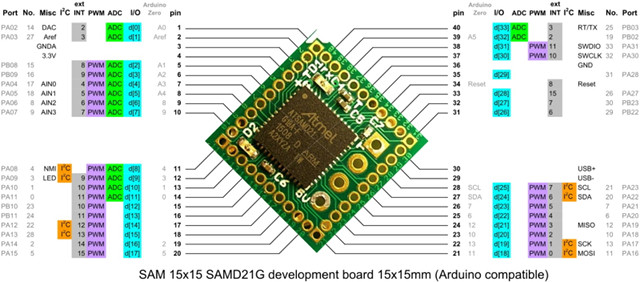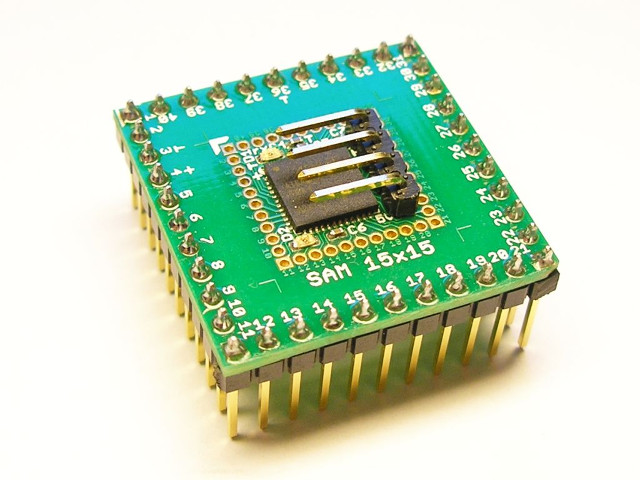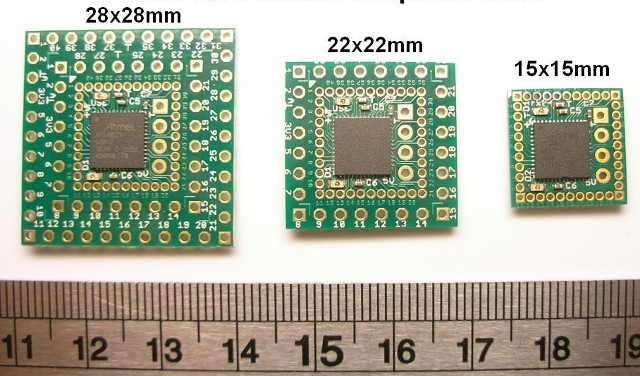Arduino Zero is an official Arduino board based on UNO r3 form factor but using Atmel SAMD21G18 ARM Cortex M0+ MCU instead of an AVR MCU. Albert van Dalen has decided to design a compatible module based on the same MCU, and called SAM 15×15, as its size can be trimmed down to as low as 15×15 mm.
SAM 15×15 comparison with Arduino Zero and Uno boards.
| SAM 15×15 | Arduino Zero | Arduino Uno | |
| Microcontroller | ATSAMD21G18A | ATSAMD21G18A | ATmega328P |
| Digital I/O Pins digitalWrite digitalRead | 34 | 20 | 14 |
| Analog Output Pins (PWM) analogWrite | 24 | 10 | 6 |
| Analog Input Pins (ADC) analogRead | 14 | 6 | 6 |
| ADC resolution | 12-bit | 12-bit | 10-bit |
| 10-bit DACs | 1 | 1 | 0 |
| Flash Memory | 256KB | 256KB | 32KB |
| SRAM | 32KB | 32KB | 2KB |
| EEPROM | 32KB (emulated in Flash) | 32KB (emulated in Flash) | 1KB |
| CPU Speed | 48MHz | 48MHz | 16MHz |
The board allows for three form factors to match your specific needs:
- 28 x 28mm – 40 pins with 2.54mm pitch; fits on a breadboard
- 22 x 22mm – Smaller version of the 28 x 28mm board with less 2.54mm pitch
- 15 x 15mm – 40 pins with 1.27mm pitch
While SAM 15×15 modules are much smaller than Arduino Zero, they come with 34 I/Os instead of just 21 I/Os on Zero board.

You can program the board with the Arduino IDE just like you’d do with an Arduino Zero, except you’ll need to solder a USB header as shown in the picture below, and use a special, yet cheap, 5-pin female to USB male cable to program it.
 Beside the link to hackaday.io in the introduction, you’ll find more details on the developer’s project page, where you can also contact him if you want to purchase the board for 24.95 Euros including worldwide shipping. Technical questions can be asked on a dedicated thread on Arduino.cc forums.
Beside the link to hackaday.io in the introduction, you’ll find more details on the developer’s project page, where you can also contact him if you want to purchase the board for 24.95 Euros including worldwide shipping. Technical questions can be asked on a dedicated thread on Arduino.cc forums.
Thanks to Nanik for the tip.

Jean-Luc started CNX Software in 2010 as a part-time endeavor, before quitting his job as a software engineering manager, and starting to write daily news, and reviews full time later in 2011.
Support CNX Software! Donate via cryptocurrencies, become a Patron on Patreon, or purchase goods on Amazon or Aliexpress. We also use affiliate links in articles to earn commissions if you make a purchase after clicking on those links.





Another similar board but compatible with Arduino Mega 2560 called the Naked Mega: http://blog.tindie.com/2017/01/small-arduino-mega-2560-compatible-board/